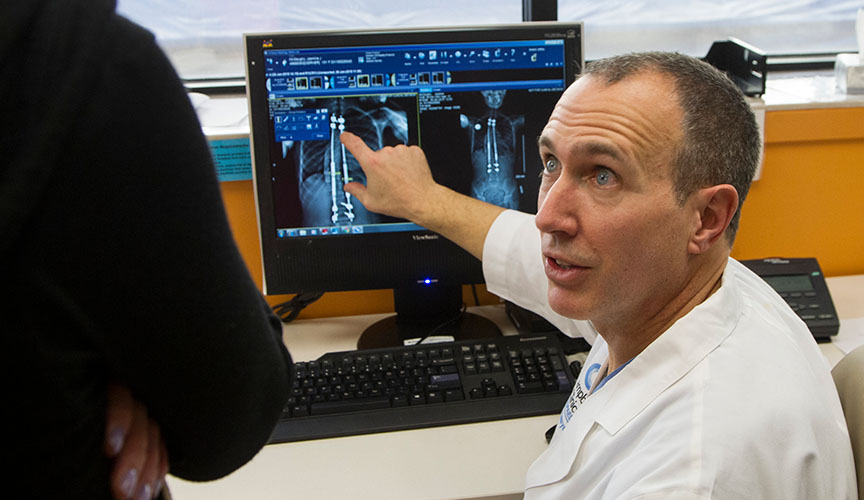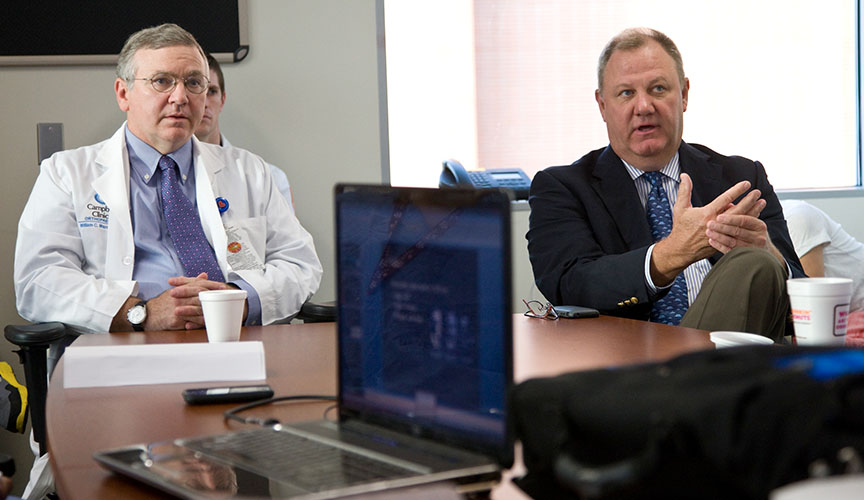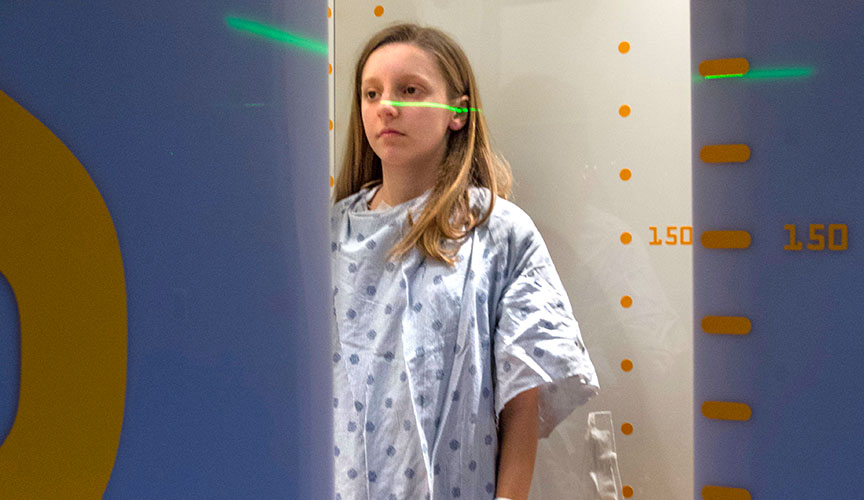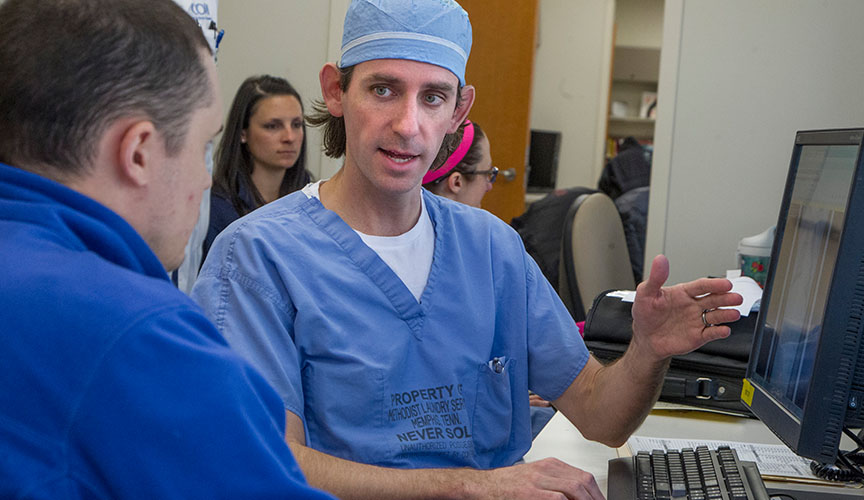Le Bonheur/Campbell Clinic team delivers comprehensive treatments for scoliosis
Le Bonheur/Campbell Clinic team delivers comprehensive treatments for scoliosis
One quick growth spurt. That’s all it took for 10-year-old Jasmine McGaughy’s scoliosis to jump from 19 degrees to an uncomfortable 59 degrees.
Noticing a slight curve, her grandmother, a massage therapist, knew something wasn’t quite right with the fifth grader’s back.The family took Jasmine to an orthopaedic surgeon near their hometown of Ripley, Miss. The plan was to monitor Jasmine’s scoliosis — at 19 degrees — too minor for any corrective treatments. When her curve progressed to more than 50 degrees in less than a year, the McGaughys were sent to the Pediatric Spine Center at Le Bonheur Children’s Hospital and Campbell Clinic Orthopaedics.Jasmine and her family became one of the first in the country to receive Magnetic Expansion Control (MAGEC) therapy. Unlike traditional growing rods, where a device is surgically implanted and lengthened every six months in subsequent surgeries, MAGEC allows surgeons to lengthen the device non-invasively – using an external magnet. It’s one of a number of tools and technologies the team is able to offer thanks to a commitment made years ago to build a comprehensive spine program.
Revolutionizing scoliosis care
Jasmine, now 13, underwent MAGEC implantation in June 2014. Since then, she’s had two adjustments, or lengthenings, in clinic – no incisions, no sedation, no recovery time. And no pain.
“We keep asking her if it hurts, and she tells us ‘no.’ It’s amazing,” said Jasmine’s grandfather, Blake. MAGEC is a stark alternative to traditional growing rods, and the Downey family, from Toxey, Ala., knows the difference. Their 9-year-old daughter, Sage, was born with arthrogryposis — a rare neuromusculoskeletal disorder — and had developed neuromuscular scoliosis by the time she was 6 months old.
The Downeys first came to Le Bonheur in 2011 when Sage was 5. Under Orthopaedic Surgeon Dr. Jeffrey Sawyer’s care, Sage underwent halo traction and Vertical Expandable Titanium Rib (VEPTR) implantation. Her VEPTR rods were surgically expanded five times.On May 7, 2014, Sage became the first person in the region to receive MAGEC rods. Her family had followed the new technology as it was first introduced in Europe and Asia and knew MAGEC would be ideal for Sage. Instead of regular surgical lengthenings like she’d experienced, MAGEC allowed Sawyer to expand Sage’s rods in a non-invasive outpatient procedure, as she grew. The technology meant fewer surgeries for Sage.“We had known about the device’s pending approval in the U.S. for a few years and knew we wanted a surgeon who would stay on top of the latest developments in scoliosis treatment,” said Janet, Sage’s mom.The Downeys trusted Sawyer, who has spent his career searching for better, less-invasive options for children with scoliosis. Sawyer is a part of a number of study groups focused on best practices for pediatric spine care and has published numerous articles on pediatric spine surgery. He’s involved in product development for scoliosis care, as well as surgeon teaching programs for scoliosis patients. Using an external magnet, Sawyer lengthened Sage’s rods for the first time on July 16, a couple months after her conversion.“It was such a difference,” said Janet. “Dr. Sawyer did the expansion in clinic. There was no anesthesia, no incisions. We were eating lunch with Sage an hour later. We couldn’t believe it.”
The technology is allowing surgeons to improve kids’ quality of life, says Sawyer. Historically, patients with severe scoliosis could expect to have multiple surgeries – as often as every six months — to straighten their spine through the course of their treatment. But MAGEC allows patients like Sage and Jasmine to undergo on-going treatment without surgery, overnight hospital stays or even an incision – and with less radiation exposure. In fact, they can return to school the same day as their expansions.“We know from studies the anxiety level of families increases every time they’re in the hospital. With MAGEC, kids can undergo an adjustment without having to stay overnight at the hospital. They can go right back to school and be kids,” said Sawyer.MAGEC also saves families the cost of missed work days. With traditional rods that require frequent surgeries, families often have to take extended time off from work and school.“Because many of our families travel a distance to see us, parents may miss several days to a week of work twice a year,” he said.
Building a comprehensive center
Sawyer and the rest of the team of 13 surgeons knew they wanted to be one of the first in the country to offer MAGEC. When they formalized the Pediatric Spine Center six years ago, they set out to provide a full range of treatment and care for any child with scoliosis, no matter the severity. Like most surgeons in the field, veteran team member William Warner, MD, has seen scoliosis care evolve tremendously in the last 20 years. Newer techniques have advanced to allow for more secure fixation and better correction.“In the 1980s, surgical care involved distraction instrumentation that required post-operative bracing or casting – meaning longer recovery time and more procedures,” said Warner. “And now with better imaging and neuromonitoring techniques certain complex deformities that couldn’t be treated in the past can now be fixed.”

“We wanted to be able to offer anything and everything in world of pediatric spine care here in Memphis,” said Warner. “It can be stressful for families to have to go somewhere far from home to have such a major procedure.”Top-notch technology would play a big role in building a comprehensive center, so the hospital invested in advanced diagnostic and treatment tools and multidisciplinary expertise.Physicians also worried about the amount of radiation exposure children with scoliosis received. For children like Jasmine who are diagnosed early in childhood with scoliosis, lifetime radiation exposure poses a significant risk to their health. At nearly each appointment, they receive radiographic scans to monitor their curve’s progression or to plan for surgery.To address those concerns, the center added an EOS imaging system, an ultra-low-dose radiation scanner that can quickly capture two-dimensional computed tomography (CT) images of the spine. EOS imaging exposes patients to about one-tenth of the dose of a plain film X-ray.
From there, the team added technologies like O- and C-arm imaging that provide real-time intraoperative CT imaging and a StealthStation® surgical navigation system to confirm placement of precision hardware in surgery. These tools benefit the more than 200 children who receive spinal surgery each year at Le Bonheur/Campbell Clinic. The list goes on. The team now offers ScoliScore™ genetic testing for a subset of patients to help predict the progression of idiopathic scoliosis, and three-dimensional printing can allow surgeons to create a real-life replica of a patient’s spine using images captured through CT. The 3-D models help surgeons prepare for surgery by studying the spine’s intricate twists and curves.“We’ve really created a one-stop shop for all things pediatric spine,” said Warner. “As we continue to develop our expertise, we’re caring for more and more children from all over the region and beyond.”
Contributing to the field
Beyond building a comprehensive center, the Le Bonheur/Campbell Clinic Pediatric Spine Center team wanted to contribute to the larger body of knowledge for scoliosis. That meant sharing its expertise, collaborating with other centers and training students in the field of pediatric spine. Since the center’s inception, the team has trained more than 100 students, residents and fellows, attracting students from across the country and around the world.
Research, collaboration improve scoliosis care
To stay up-to-date on the latest in the field and expand their expertise, the team:
- Is a part of several study groups, like the current multi-center group studying the nuances of MAGEC and a multi-center retrospective analysis of Vertical Expandable Titanium Rib (VEPTR) surgery infection rates. This allows Le Bonheur/Campbell Clinic to not only help develop care guidelines and protocols, but also to access the latest information on diagnosis and treatment before it even is presented at meetings or published in medical journals.
- Regularly consults with biomedical engineers in the industry, offering their insights and experience.
- Publishes and presents peer-reviewed articles about topics. The team has published several spine-related studies in the last five years on topics like surgical infection rates, VEPTR anchor failure and spinal cord trauma.
- Monitors quality measures, like surgical infection rates – an important measure for any spine program. Surgeons have only seen two infections out of more than 500 cases in the last five years, a rate of about .039 – among the lowest in the country.
- Trains students from across the country and around the world through its reputable fellowship program. The Spine Center has trained more than 100 students, residents and fellows since its inception.
Brazilian native Nelson Astur, MD, turned Brazilian native Nelson Astur, MD, turned to Le Bonheur/Campbell Clinic when he wanted to improve scoliosis treatment for children in his country. He’d referenced “Campbell’s Operative Orthopaedics” throughout his orthopaedic residency in Sao Paulo and applied to the center’s Pediatric Spine Research Fellowship program in 2010.“Spending a one-year fellowship with the Pediatric Spine team was a game-changing experience for my practice. The experience means even more now when I still have the opportunity to collaborate with my mentors to solve cases in Brazil. Even better when this link is still producing research and new projects,” said Astur.

The Pediatric Spine Center is also part of several multi-center spine study groups, including a recently formed MAGEC study, as well as a multi-center retrospective analysis of Vertical Expandable Titanium Rib (VEPTR) surgery infection rates. Le Bonheur’s Orthopaedic team has published 13 spine-related articles in the last five years. Studies have focused on the efficacy of operative and non-operative treatments for scoliosis, spinal trauma, as well as the safety and effectiveness of diagnostic tools, like EOS imaging.“Through our research, collaboration and teaching efforts, we are able to share our experience and knowledge with other surgeons and centers to help provide the best possible spine care for children in the United States and around the world,” said Orthopaedic Surgeon David Spence, MD. “The work also gives us access to the most recent research and outcomes often times before they are published in journals and textbooks.”The center’s surgeons also collaborate with some of the brightest minds in biomedical engineering. Medical technology companies like Medtronic, Medicrea and Depuy Synthes regularly invite the team to consult on their work. The Pediatric Spine Center has recently partnered with Medtronic on an outreach initiative designed to help local schools identify scoliosis. They hope the program, called Spine Check, will lead to earlier and more effective treatment for children with scoliosis.
True to the Pediatric Spine Center’s original vision, the team says it will continue to search for better ways to care for children with scoliosis. Surgeons are working toward using biomechanics to improve bracing outcomes and compliance and studying the biomechanics of multi-rod construct in children with spinal osteotomies. Using EOS, surgeons hope to better understand the 3-D corrections achieved by various spinal deformity implants.
“Personalized care for patients at our spine center provides all the resources for a successful outcome for families facing scoliosis,” said Sawyer. “Our work is allowing us to provide the latest, safest and best spine care to our patients and their families.”
Help us provide the best care for kids.
Le Bonheur Children's Hospital depends on the generosity of friends like you to help us serve 250,000 children each year, regardless of their family’s ability to pay. Every gift helps us improve the lives of children.
Donate Now









